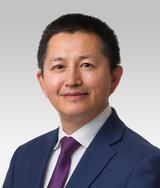
March 2025 Newsletter

March 2025 Newsletter

Sponsored Research
PI: Yan Liu, PhD, associate professor in the Department of Medicine in the Division of Hematology and Oncology
MPIs: Feng Yue, PhD, Duane and Susan Burnham Professor of Molecular Medicine, and Madina Sukhanova, PhD, associate professor of Pathology
Summary: Acute myeloid leukemia (AML) is an aggressive blood cancer that affects roughly three million Americans, and five hundred thousand people die from AML each year. Previous studies indicate that AML is initiated and maintained by a rare population of leukemia-initiating cells (LICs) that are often malignant versions of hematopoietic stem cells (HSCs). Somatic mutations of tumor suppressor gene TP53 in AML are associated with high-risk disease, complex karyotype, resistance to therapies and dismal outcomes. Thus, there is a critical need to identify novel therapeutic targets to improve the treatment outcomes of AML patients with TP53 mutations. We discovered gain-of-function (GOF) mutant p53 proteins frequently found in AML enhance colony formation in vitro and HSC self-renewal in vivo. Utilizing RNA-seq, we observed that p53 mutant HSCs exhibit an enrichment in HSC self-renewal gene signatures. Our ATAC-seq assays showed significant changes in chromatin accessibility in p53 mutant HSCs compared to wild type (WT) HSCs. Our ChIP-seq assays showed that p53 mutant HSCs display high level of repressive histone mark H3K27me3 compared to WT HSCs. Higher-order chromatin structure is emerging as an important regulator of gene expression. Utilizing Hi-C, we discovered that GOF mutant p53 generates specific chromatin loops and alters A/B chromatin compartmentation in leukemia cells, which may contribute to dysregulated gene expression in leukemia cells.
Our objective for this research is to determine the role of GOF mutant p53 in the regulation of LIC self-renewal, chromatin accessibility, and 3D chromatin structure in LICs and leukemia cells. The central hypothesis is that specific GOF mutant p53 proteins promote leukemogenesis and mediate therapy-resistance by interacting with transcription regulators that remodel chromatin accessibility and structure in LICs. We will employ multidisciplinary and complementary approaches, including molecular, biochemical, genetic, and pharmacological approaches, as well as unbiased proteomic and genome-wide RNA-seq, ATAC-seq, ChIP- seq, and Hi-C studies to elucidate the mechanisms by which GOF mutant p53 proteins promote leukemogenesis and mediate therapy-resistance.
We anticipate that this research will uncover novel mechanisms whereby GOF mutant p53 affects transcription, chromatin accessibility, and 3D chromatin structure in HSCs and AML cells. Therefore, our research will address a significant gap in knowledge regarding the mechanisms by which GOF mutant p53 enhances LIC self-renewal, providing novel therapeutic targets for therapy-resistant TP53-mutant AML.